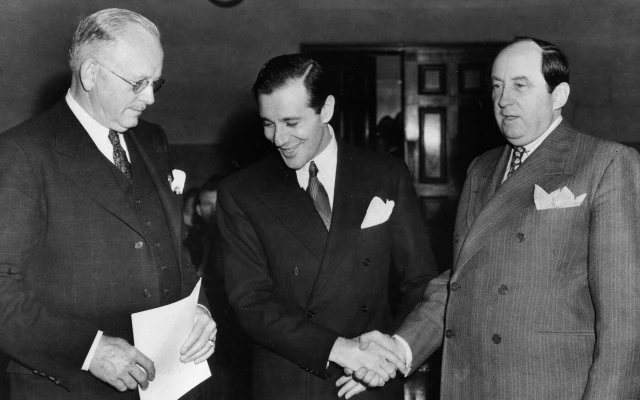
On the night of June 20, 1947, one of the most infamous figures in American organized crime—Benjamin “Bugsy” Siegel—was shot to death in the lavish Beverly Hills home of his girlfriend, Virginia Hill. The bullets that tore through his body ended the life of a man who had risen from Brooklyn’s brutal streets to become a Hollywood socialite, a mob visionary, and the face of the Flamingo Hotel in Las Vegas.
But behind his movie-star looks and charm, Siegel was a cold-blooded killer, a mobster whose ambition—and recklessness—may have cost his life. His murder remains one of the most notorious unsolved killings in American mob history, filled with betrayal, greed, and the brutal rules of the underworld.
Who Was Bugsy Siegel?
Born Benjamin Siegelbaum on February 28, 1906, in Brooklyn, New York, Bugsy Siegel grew up in poverty and quickly immersed himself in crime. He became a founding member of Murder, Inc., the mafia’s contract killing arm, alongside his lifelong friend Meyer Lansky.
Unlike many of his contemporaries, Siegel combined brutality with vision. He wasn’t just a trigger man—he was a thinker, a dreamer, and, some say, a narcissist with a taste for the finer things. While Lansky remained behind the scenes, Siegel embraced the spotlight, cultivating friendships with Hollywood elites like George Raft, Clark Gable, and Jean Harlow.
By the 1930s, Siegel had become the mob’s representative on the West Coast, overseeing rackets in gambling, narcotics, prostitution, and extortion. But his most ambitious project would take him into the middle of a Nevada desert—and to the edge of his criminal empire.
The Flamingo Hotel: Dream or Disaster?
Bugsy Siegel didn’t invent Las Vegas, but he helped create the myth.
In the early 1940s, the mafia was looking to expand its gambling operations. The sleepy desert town of Las Vegas had just legalized gambling, and Siegel envisioned building a luxurious hotel and casino that would rival anything in Havana or Hollywood—something never before seen in the American West.
That dream became the Flamingo Hotel, funded by mob money—primarily from East Coast syndicates and Lansky’s connections. Siegel took control of construction in 1945, but his taste for luxury and lack of business discipline led to massive cost overruns, delays, and suspicions of embezzlement.
The Flamingo’s initial construction budget was $1 million, but it ballooned to over $6 million (nearly $80 million today). Siegel’s erratic management style, accusations of skimming, and arrogant refusal to answer to the mob’s financial backers led to mounting fury from New York and Chicago bosses.
When the Flamingo opened prematurely on December 26, 1946, it was a disaster. Rainstorms soaked the desert, celebrities left early, the hotel wasn’t finished, and it hemorrhaged money. It was a public embarrassment, and Siegel—once the golden boy—was now a liability.
Though the Flamingo later became profitable, it was too late. The mob had lost patience.
June 20, 1947: The Assassination
On the night of June 20, 1947, Bugsy Siegel was reading a newspaper in the living room of Virginia Hill’s rented home at 810 North Linden Drive, Beverly Hills. Hill herself was in Europe, possibly warned to stay away.
At 10:45 p.m., an unknown shooter fired through the front window using a .30-caliber military M1 carbine rifle. Siegel was hit multiple times, including two fatal shots to the head—one of which destroyed his right eye and exited his skull, hurling it across the room.
He died instantly, slumped over on the couch, still holding the newspaper.
The assassination was clean, fast, and professional. The hit bore the unmistakable hallmarks of a mob execution.
The Prime Suspects and Motives
While no one was ever charged with Siegel’s murder, the list of suspects and motives was long:
1. The Mob Syndicate
Most agree that the national crime syndicate ordered the hit, likely orchestrated by Meyer Lansky, with either Chicago or New York gunmen pulling the trigger.
Siegel’s alleged embezzlement, his failure to deliver profits, and his defiance of the mob’s accountants were unforgivable sins. The Flamingo was mob money, and Bugsy was treating it like a personal vanity project.
2. Virginia Hill’s Brother or Associates
Some theories suggest Hill’s criminal associates or jealous lovers may have been involved, or that Hill was used as bait to isolate Siegel before the hit.
3. Betrayal From Within
There’s long been suspicion that his closest allies may have approved the hit, including Lansky—his childhood friend. Though deeply personal, the mob didn’t mix friendship with business.
Aftermath: Business as Usual
Just hours after Siegel’s death, mob enforcers arrived at the Flamingo in Las Vegas to take control. The timing was so swift it suggested the assassination was well-orchestrated and pre-approved at the highest levels.
The Flamingo went on to become a massive success, and Las Vegas exploded into a mob-financed playground, with casinos like the Sands, Tropicana, and Stardust following Siegel’s original blueprint.
Bugsy’s murder had not only removed a liability—it had sent a clear message:
No one is bigger than the mob.
The Hollywood Myth and Cultural Legacy
Siegel’s life and death have fascinated generations, inspiring countless portrayals in film and literature:
-
Warren Beatty starred as Bugsy in the 1991 film Bugsy, which dramatized his romance with Virginia Hill and the Flamingo project.
-
Documentaries and books have examined the glamour, danger, and delusion that defined his final years.
-
He became a symbol of mob ambition and excess, a man who wanted to be both feared and adored—and died for both.
In Beverly Hills, the home where he was killed still stands. The bullet holes were long since patched, but the legend remains.
Conclusion: The Dreamer Who Flew Too Close to the Sun
Bugsy Siegel’s murder was more than a mob hit—it was the violent end of a dreamer who believed he could outshine the shadows that made him. He built a glittering palace in the desert, played Hollywood royalty, and thought he could rewrite the mob’s rules.
But the underworld has no tolerance for loss, betrayal, or ego—no matter how handsome the face or grand the vision. In the end, Bugsy Siegel became a cautionary tale wrapped in silk and gun smoke, a man who dreamed of neon lights but couldn’t see the crosshairs on the windowpane.
